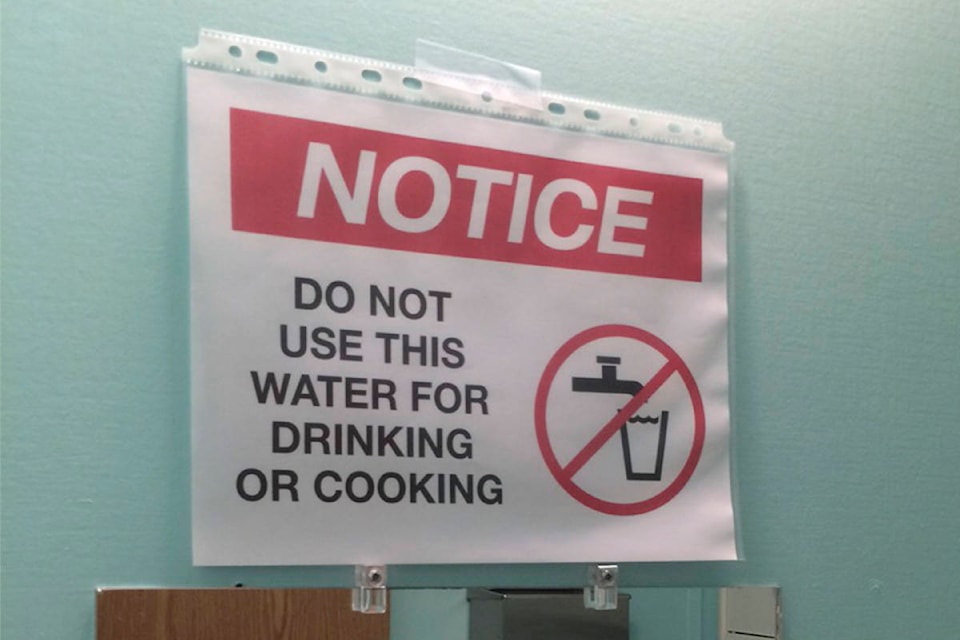In a sudden about face, lead levels in water at Yukon schools have been published on the Department of Education’s website, and it appears that the concentration from at least one fixture was substantially higher than the territory’s safety standard.
The Yukon’s Chief Medical Officer Brendan Hanley said even the higher levels don’t pose a health risk to children or staff.
Last month Hanley refused to hand over the data showing the lead levels to the News. He had said doing so could jeopardize ongoing work.
The Yukon government is identifying water fixtures hooked up to school fountains and sinks for replacement. Over the summer, about 160 of the components were tagged.
The test results were published on Oct. 1.
Robert Service School, in Dawson City, had 34 fixtures, including one drinking water fountain and one kitchen sink, marked for replacement, the highest of any school surveyed. One of those components, attached to a classroom sink, had 431 micrograms per litre, according to the test results, which would mean 411 micrograms above the territorial standard. A fixture connected to a drinking water fountain had 34.5 micrograms of lead per litre.
The territorial standard for acceptable levels of lead is 20 micrograms per litre.
Twenty-six components were identified for replacement at Eliza Van Bibber School in Pelly Crossing. One fixture, connected to another classroom sink, contained 88 micrograms of lead per litre, according to the test results.
Some fixtures were tested a second time after flushing. One component, at Ghùch Tlâ Community School, in Carcross, initially tested at 239 micrograms per litre; the flushed sample, however, came in at 12.3 micrograms per litre.
Government staff have gone back to schools to ensure flush samples have been completed, Department of Education spokesperson Kyle Nightingale said. When the outstanding results come in, they will be published online, he added.
“None of these results, even the higher ones, pose a health hazard to children or staff as they represent transient levels of lead at fixture sites associated with stagnated water in the fixture, i.e. after 16 hours of still water with leaching from the fixture,” Hanley said in a written statement.
“You will note that the levels reduce immediately with flushing, as demonstrated by the tier two results where these were applied, and as supported by lead levels in source water that are below Health Canada standard.”
All fixtures where lead levels were gauged above the standard have been taken offline and identified as such, Hanley added.
“There are plans to replace the fixtures but naturally this will take some time to complete.”
Phase one involved inspecting all water fixtures in schools built before 1990 this summer. Stage two will occur next summer, targeting schools built post-1990.
In a previous interview, Hanley had told the News that some of the components were “up to 30 years old.”
If there’s a high yield of lead in the first flush of water and not in the second, it means it’s the fixtures, he said.
During question period on Oct. 1, Stacey Hassard, interim leader of the Yukon Party, said that teachers, students and teachers weren’t notified of elevated lead levels until three weeks into the school year.
“I believe that parents, families, children and teachers have the right to know what those lead levels are in the schools’ drinking water,” he said. “Why is this Liberal government refusing to share this important information with Yukon parents?”
Education Minister Tracy-Anne McPhee said her department shared the testing results with the school community “at the earliest possible time.”
When pressed by Hassard as to why the data wasn’t made public at an earlier date, McPhee said results are available on the departmental website “and have been for a bit of time.”
“I spoke with the department as late as last week to determine that those figures would be going up on the website for anyone to review,” McPhee said.
Speaking with reporters after question period, Hassard said that the lead testing results were published to the department’s website “10 or 15 minutes” after he asked why the Liberals held back from doing so earlier.
Nightingale could not provide a specific time as to when the data was published, but said it went up on the department’s website after 12 p.m.
McPhee told the News on Oct. 2 that the results were not published because of what occurred during question period.
“I had a conversation last week about those being posted. I understood last week that they were posted already,” she said.
“I think it was a caution to try to not confuse the matter by publishing results of tests that people wouldn’t really understand,” she said, referring to why the data was withheld from public view. “Obviously we made that decision differently now and it makes sense. If people want to look at them, they should have them.”
Contact Julien Gignac at julien.gignac@yukon-news.com
